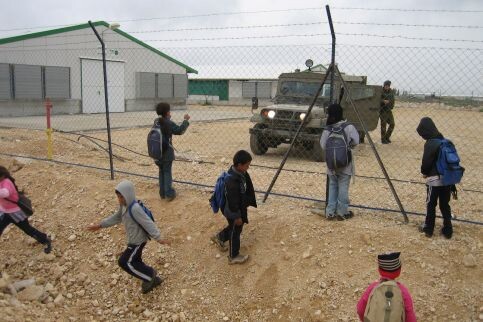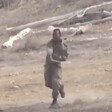The Electronic Intifada al-Tuwani 21 February 2011

Children play near Israeli soldiers in Tuba village in the occupied West Bank. (Samuel Nichols)
On the afternoon of 7 February 2011, masked Israeli settlers from Havat Maon outpost chased a group of twelve Palestinian schoolchildren who were walking home from school in al-Tuwani village in the occupied West Bank’s South Hebron Hills. The Israeli military had failed to arrive to escort the schoolchildren, forcing the children to take a longer path without the army’s escort.
Since 2004, Christian Peacemaker Teams and Operation Dove have documented more than 110 acts of settler aggression against Palestinian schoolchildren from Tuba and Maghayir al-Abeed villages in the South Hebron Hills (see “The Dangerous Road to Education: Palestinian Students Suffer Under Settler Violence and Military Negligence, December 2010 [PDF]). The details of the attacks may vary, but the crux of every incident is the same: the Israeli military fails to arrive in order to escort the schoolchildren past Maon settlement and Havat Maon settlement outpost; the children are forced to walk an indirect route without escort; settlers emerge from the outpost and chase or assault the children.
The implementation of the military escort, in November 2004, was precipitated by a September 2004 incident in which a dozen masked settlers ambushed five children and two accompanying internationals on the road. One settler hit a young girl, Miriam Abu Jundiyye, on the head with a stick. The children ran back to Tuba, and the settlers beat the two internationals, who were injured and needed hospitalization.
Each afternoon, an average of 18 children, ages 5-14, are dismissed from school and make their way towards the road that serves Tuba and Maghayir al-Abeed. In the late 1990s, Palestinians using the road increasingly came under attack from violent settlers. By 2003, Palestinians were forced to stop using the road completely. Since the beginning of the escort, the children have waited daily, in the shadow of Maon and Havat Maon, for the arrival of a military escort which permits them passage through an area that settlers have annexed through the use of violence. The children often wait for hours and struggle to find activities to fill their time — playing sports or getting an early start on homework assignments. During harsh summer and winter weather, the children find protection from the elements under evergreen trees planted by the Jewish National Fund to demarcate the area as Jewish land.
As I sat with the kids on 7 February 2011, they were becoming increasingly impatient. They had finished their two-week winter recess that provided a reprieve from the daily uncertainty of whether their journey home would be uneventful or dangerous. As the kids became increasingly eager to take the long way home, instead of waiting for the military escort, I became frustrated with their impatience — even though I knew my frustration was misplaced.
I had called the military dispatch office four times, encouraging them to send the escort. Twice they answered and told me they would send the soldiers. On my third call, they hung up. On the fourth call, the dispatcher informed me that the office had not even called the soldiers because the soldiers had more important duties to perform.
During the call, the kids were climbing on my arms and legs, trying to get their ears closer to the phone to hear what the military personnel were saying. What did they say? Are the soldiers coming? I could not bear to tell them the truth, that the officers did not care what happened to them, so I lied. Yeah, they are on their way here, just wait a few more minutes.
Finally, the kids’ patience ran out, and they set off on the longer path that skirts along the perimeter of Havat Maon outpost. Mere minutes after setting out on the sixty-minute journey over rough, rocky hills, the kids spotted a settler in the trees that obscure the outpost. The kids scrambled in retreat while I struggled to turn on my video camera as I ran backwards. After getting a safe distance from the place where they saw the settler, the older kids in the group discussed our options and decided we should descend into the adjacent valley, to distance ourselves from the outpost, and continue heading towards Tuba and Maghayir al-Abeed.
The older children were confident in their choice — they have made important decisions like this countless times before. The instant we started to head deeper into the valley, my colleague, who was watching from a nearby hilltop, called to say three settlers were moving down the valley in our direction.
Before she finished speaking, I yelled to the kids, “Come back here, quickly, there are three settlers coming down the hill towards us; they are masked!” My warning passed quickly to the front of the group, and the kids again quickly distanced themselves further from the outpost.
Once we stopped, I saw that several of the younger children were distraught. One young girl, Inshirah, was pacing back and forth with her hands on her head, her whole body shaking. She was pleading with everyone, or with no one in particular, to go back and wait for the army. “Please, I don’t want to walk on this path, please, I’m scared of the settlers,” she pleaded.
Villagers from al-Tuwani came out towards us once they saw the settlers approaching. One of the village leaders, Khaled, shouted instructions to the children. As more al-Tuwani villagers began to stream out of their houses in support, the Israeli Border Police arrived. The settlers, still masked, approached the jeep and spoke with the Border Police officers, gesturing and pointing, apparently narrating their version of events before heading back to the outpost.
Khaled and I approached the Border Police; I began by complaining of the late arrival of the military escort and demanding that action be taken against the settlers’ threatening behavior. Khaled spoke at length with another policeman who suggested the source of the problem was the schoolchildren walking too close to the outpost, which forced the settlers to come out. He also suggested that the al-Tuwani villagers routinely provoke the settlers, and the international activists are on hand to document the settlers’ response to the Palestinians’ provocations. Khaled remained calm and refuted the policeman’s claims by recounting the details of several recent attacks against his own family as well as explaining the consistent trend of violence and land annexation since the establishment of Maon settlement in 1981.
After hearing from the military that they were not providing an escort for the schoolchildren that day, the Border Police agreed to escort the children on the direct path to Tuba and Maghayir al-Abeed. They opened up the back door of the jeep to keep an eye on the children following behind the jeep. I saw them laughing as the jeep sped up and the kids, some of whom were still shaking in fear, had to run to catch up.
Given that more than 110 acts of settler aggression have been documented against one small group of children in the span of six years, one wonders how many thousands more attacks on children have happened across the West Bank in the same period. These incidents do not make international news, Israeli news, or even Palestinian news — settlers killing Palestinians, home demolitions and the ethnic cleansing of Jerusalem are bigger news items than masked thugs chasing kids after school. But the children targeted by these acts of settler aggression are forever scarred — both by the attacks and by the system that deems them unworthy of protection.
Nevertheless, the children from Tuba and Maghayir al-Abeed are living examples of samoud — resolute steadfastness. They refuse to let acts of aggression and violence deny them access to education, and continue to struggle against the occupation of their land by making the journey to school each day.
Samuel Nichols is an activist from the US working with Christian Peacemaker Teams, an organization that supports Palestinian-led nonviolent resistance to the Israeli occupation. He lives in al-Tuwani, a small village in the South Hebron Hills, amongst Palestinians committed to nonviolent resistance to land confiscation and settler violence. Follow him on his blog, Do Unto Others, and on Twitter.



